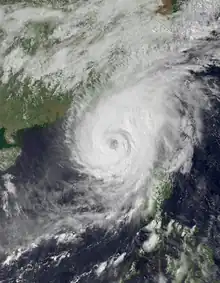 Typhoon Dan at peak intensity on October 7 | |
| Meteorological history | |
|---|---|
| Formed | October 2, 1999 |
| Dissipated | October 10, 1999 |
| Typhoon | |
| 10-minute sustained (JMA) | |
| Highest winds | 150 km/h (90 mph) |
| Lowest pressure | 955 hPa (mbar); 28.20 inHg |
| Category 3-equivalent typhoon | |
| 1-minute sustained (SSHWS/JTWC) | |
| Highest winds | 205 km/h (125 mph) |
| Lowest pressure | 955 hPa (mbar); 28.20 inHg |
| Overall effects | |
| Fatalities | 44 total |
| Damage | $242 million (1999 USD) |
| Areas affected | |
| IBTrACS | |
Part of the 1999 Pacific typhoon season | |
Typhoon Dan, known in the Philippines as Typhoon Pepang, was a tropical cyclone that affected multiple areas in the Western Pacific Ocean. As the twenty-third tropical storm and the fifth typhoon of the 1999 Pacific typhoon season, it originated from a tropical depression in the Philippine Sea. The depression strengthened to a tropical storm two days later, attaining the name Dan.
Heavy rainfall and major flooding hit the Philippines, China, and Taiwan. 44 people died, and around $432.8 million (2022 USD) in damage was caused due to Dan.
Meteorological history

Tropical storm (39–73 mph, 63–118 km/h)
Category 1 (74–95 mph, 119–153 km/h)
Category 2 (96–110 mph, 154–177 km/h)
Category 3 (111–129 mph, 178–208 km/h)
Category 4 (130–156 mph, 209–251 km/h)
Category 5 (≥157 mph, ≥252 km/h)
Unknown
An area of low pressure, would be upgraded to a tropical depression, designated as 26W, developed over the Philippine Sea on October 1 about 750 km (470 mi) to the east of Luzon.[1] The PAGASA designated the system Pepang.[2] The system intensified as it moved west-northwest, making the system gain the name Dan on October 3. Dan would strengthen to a typhoon status the next day. Typhoon Dan reached its peak with winds of 205 kilometres per hour (125 mph) early on October 5 and hit northern Luzon at that strength. The typhoon weakened as it entered the South China Sea, but re-intensified as it turned towards the north. Typhoon Dan made its second landfall near Xiamen, China on October 9 and weakened overland. Dan turned to the northeast and weakened to a tropical depression before it moved over the Yellow Sea late on October 10, later getting absorbed by a frontal system over the Yellow Sea early the next day.[1]
Preparations and impact
China
Thirty-four died and 1,400 people were injured as a result of the storm in Fujian. 1,500 houses were destroyed and $240 million of damage occurred in the province.[3] Dan was the worst typhoon to hit Xiamen in 46 years, killing five and injuring over 100 in the city.[1] In Zhangzhou, collapsing buildings resulted in seven deaths. Eighteen people were killed nearby in Quanzhou.[4] Dan caused more damage on top of an earthquake that had occurred not long before Dan's landfall.[5]
Philippines
Typhoon Dan brought torrential rain of up to 500 mm (20 in), affected 2,600 homes and killed at least five people. Hundreds of houses were damaged in Northern Luzon. There was more than $2 million of damage to agriculture in the Philippines.[3]
Taiwan
Typhoon Dan brought torrential rain of up to 500 mm (20 in) to southern Taiwan.[6] Southern Taiwan was still recovering from the Jiji earthquake of the previous month, and Dan delayed the recovery efforts. The typhoon burst a dike in Kaohsiung and another in Tainan, that had been damaged by the earthquake. Dan knocked down a large number of trees on Kinmen, which led to the disruption of 70% of the island's power supply. Several fishing boats were sunk and houses were damaged on Penghu.[7] Over 850 areas of Taiwan were put under a landslide warning.[8]
See also
- Tropical cyclones in 1999
- Typhoon Nora (1973) – the strongest category 5 typhoon by barometric pressure, which affected similar areas.
- Typhoon Thelma (1977) – took a similar track.
- Typhoon Clara (1981) – a category 4 typhoon that affected the Philippines, China, South Korea, and Japan.
- Typhoon Hal (1985) – affected Northern Luzon as a category 3 typhoon and made landfall in China.
- Typhoon Percy (1990) – a category 4 typhoon affected similar areas.
- Typhoon Nuri (2008) – a category 3 typhoon that took a similar track.
- Tropical Storm Linfa (2009) – took a nearly identical track.
- Typhoon Megi (2010) – a category 5 typhoon that took a comparable track.
- Typhoon Haima (2016) – a very intense typhoon that made landfall in Luzon and China.
- Typhoon Doksuri (2023) – a Category 4 typhoon that also caused widespread damage in Luzon and China.
References
- 1 2 3 "Typhoon Dan (26W)" (PDF). 1999 Annual Tropical Cyclone Report. p. 111. Archived from the original (PDF) on 2016-12-24. Retrieved November 9, 2022.
- ↑ Padgett, Gary. "Monthly Global Tropical Cyclone Summary: October 1999". Archived from the original on 23 March 2007. Retrieved November 9, 2022.
- 1 2 "Typhoon Dan (9920)" (PDF). Hong Kong Observatory. April 2000. pp. 92–95. Archived from the original (PDF) on 2011-05-24. Retrieved November 9, 2022.
- ↑ "1999 Pacific Typhoon Summary" (PDF). metoc.navy.mil. Retrieved 2022-11-22.
- ↑ "Relief as Typhoon Dan set to miss island". South China Morning Post. 1999-10-06. Retrieved 2022-11-23.
- ↑ "Weekly Global Climate Highlights". 1999-10-09. Archived from the original on 2006-10-11. Retrieved November 9, 2022.
- ↑ "Typhoon Dan downs power lines, uproots trees in the south". Taipei Times. 1999-10-10. Retrieved November 9, 2022.
- ↑ "Landslides fear in wake of typhoon". South China Morning Post. 1999-10-09. Retrieved 2022-11-23.